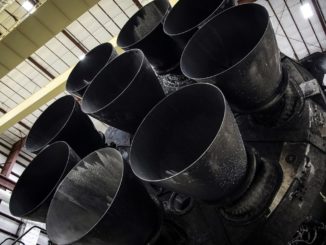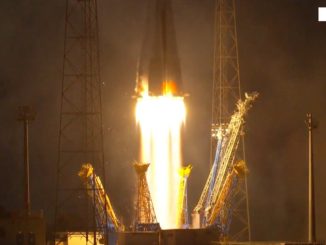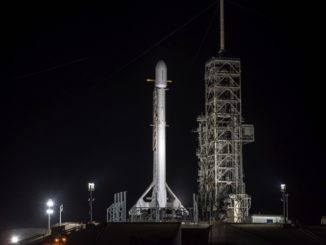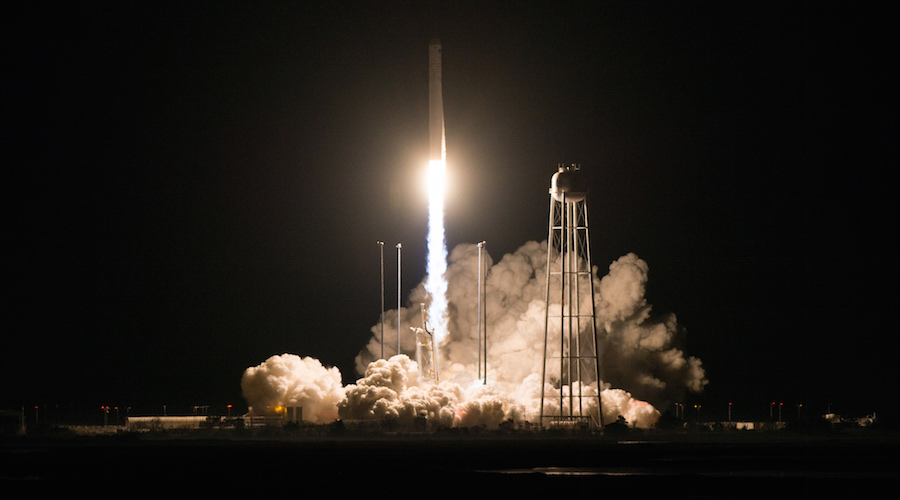
A Northrop Grumman Antares rocket and Cygnus cargo carrier climbed into orbit Saturday from Wallops Island, Virginia, in pursuit of the International Space Station with more than 7,200 pounds of research hardware and provisions, the second supply ship launch to the space station in less than 24 hours.
The unpiloted commercial cargo ship rode the 139-foot-tall (42.5-meter) Antares rocket away from the Mid-Atlantic Regional Spaceport, a facility owned by the state of Virginia on the Atlantic coastline at Wallops Island.
The Antares rocket’s first stage, with fuel tanks built in Ukraine and Russian-made RD-181 engines, propelled the launcher into a clear predawn sky with 864,000 pounds of thrust. The Antares guidance computer commanded the engines to gently pivot, steering the rocket toward the southeast over the Atlantic Ocean to align with the space station’s pathway.
Three-and-a-half minutes into the flight, the first stage shut down and separated, leaving the Antares upper stage — powered by a solid-fueled U.S.-built Castor 30XL rocket motor — to finish the job of accelerating the Cygnus supply ship into orbit.
The Cygnus spacecraft separated from the Antares upper stage around nine minutes after liftoff, arriving in an on-target preliminary orbit to begin a two-day chase of the space station, culminating in its capture by the lab’s robotic arm at 5:20 a.m. EST (1020 GMT) Monday.
“Not only was it a beautiful launch this morning, it put Cygnus exactly where we wanted it in orbit,” said Frank DeMauro, vice president of advanced programs at Northrop Grumman Innovation Systems, which developed and owns the Antares rocket and Cygnus spacecraft. “The spacecraft, after separation, we were able to communicate (with it) extremely quickly and start conditioning. We initialized the guidance system and the propulsion system. That all checked out really well.
“Then we began the process of deploying the solar arrays, which I’m happy to report have been successfully deployed and are generating lots and lots of power, so the spacecraft is extremely healthy and is ready to begin its trek to the ISS,” DeMauro told reporters after launch.
The Cygnus spacecraft joined a Russian Progress resupply freighter in orbit following its launch Friday from Kazakhstan. The Progress cargo capsule is due to arrive at the space station with a docking around 2:30 p.m. EST (1930 GMT) Sunday, followed by the capture of Cygnus with the station’s robotic arm Monday.
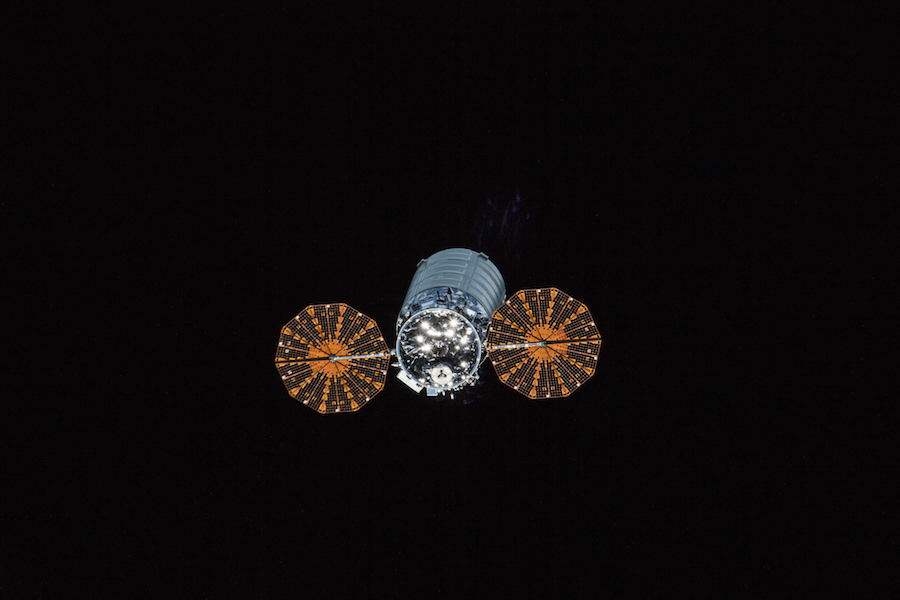
The Antares launch in Virginia was delayed two days by rainy weather.
“While we were waiting on the weather out here at Wallops, we had an awesome Progress launch out of Baikonur, Kazakhstan on Friday,” said Joel Montalbano, NASA’s deputy space station program manager. “We’re looking forward to both vehicles being attached to the International Space Station and the crew working on them getting the science, getting the research out, getting all the equipment that we’ve bought up on these vehicles, and continuing the great work we do on the International Space Station.”
NASA astronaut Serena Auñón-Chancellor will be at the controls of the station’s Canadian-built robotic arm to snag the Cygnus cargo craft Monday. She is joined by European Space Agency commander Alexander Gerst and Russian cosmonaut Sergey Prokopyev on the orbiting outpost 250 miles (400 kilometers) above Earth.
Two additional crew members were supposed to be on the station, but their launch was aborted two minutes after liftoff Oct. 11 aboard a Soyuz rocket from Kazakhstan. Soyuz commander Alexey Ovchinin and NASA astronaut Nick Hague safely landed downrange after the launch emergency.
The accident left the station with a three-person crew for weeks longer than anticipated, until three fresh crew members launch on another Soyuz flight Dec. 3. Gerst and company will depart the station in their Soyuz landing craft Dec. 20, leaving the three newly-arrived residents in orbit until another Soyuz crew arrives in the spring.
With only three people on the station — rather than the typical five or six — Montalbano said some research activities have been reprioritized, but operations have not been significantly impacted.
“As far as science, with two less people … you’ll do a little less activities on-board, but it’s just for a short time, and actually the crew members on-board have picked it up, and they’ve been really working hard and picking up the things that had to get done,” he said. “Any science or research that’s time-critical, it’s being done, and we’re reprioritizing other activities, so from that standpoint, we’re doing actually very well.”
The Cygnus supply ship — flying on the NG-10 cargo mission — is set to deliver 7,215 pounds (3,273 kilograms) of supplies and experiments to the space station, including a plastic recycler and 3D printer built to advance in-space manufacturing capabilities, and an experiment studying how the human body’s ability to perceive motion, orientation and distance changes in microgravity.
The recycler and printer, called the Refabricator, is a tech demo aimed at analyzing how future space missions could manufacture tools and spare parts on-board, without requiring resupply from Earth. It was developed by Tethers Unlimited under contract to NASA.
“At Tethers, we developed, designed and tested the Refabricator,” said Allison Porter, flight missions manager at the company based near Seattle. “Basically, we’re melting down polymers and making them into 3D printer filament … Once the Refabricator recycles and makes new filament, we are able to print new parts.”
The space station already has a 3D printer on-board provided by a company named Made in Space. But that device, intended as a proof-of-concept for 3D printing in space, needs fresh material from Earth to be fed into it.
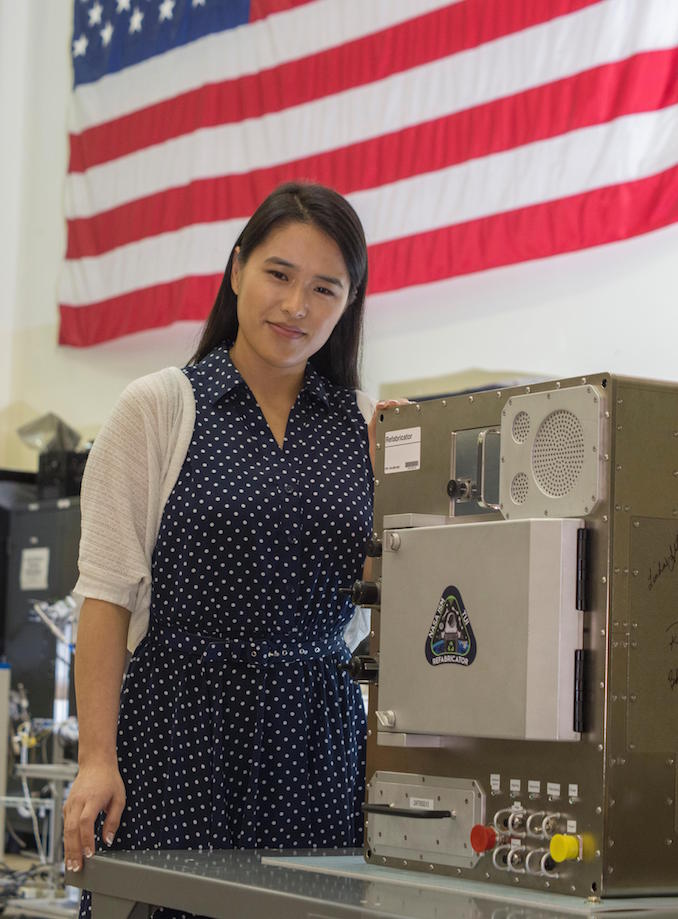
“When all the results were in, we found out that there were no engineering significant microgravity effects,” said Diane Risdon, In-Space Manufacturing Refabricator project lead at NASA’s Marshall Space Flight Center in Alabama. “So now we have our 3D printer, we know that it works in space. The next thing is where do we get the filament? … Do we have to upload that? We’re trying to avoid large masses being uploaded, so we’ve got to find a sustainable source for filament.
“On the ISS, we know that there’s multitudes and multitudes of plastic baggies,” she continued. “The crew complains, what do we do with all of these baggies? They also have packaging — plastic packaging — they use food plastic containers, plastic medical devices, so periodically they round up all this trash and burn them in space.
“We’re thinking, well, there’s our resource,” Risdon said. “If we can recycle these, then we’re on our way to getting our filament.”
Another science investigation aboard the Cygnus spacecraft will examine the processes at the origin of the solar system that led the formation of dust particles that eventually grew into larger objects, leading to the birth of the planets. The experiment, led by researchers at Goethe University in Frankfurt, Germany, “zaps a specially formulated dust with an electrical current and then studies the shape and texture of pellets formed from these steps in the absence of gravity,” according to a NASA overview of the investigation.
Here’s a breakdown of the cargo manifest provided by NASA:
- 2,515.5 pounds (1,141 kilograms) of crew supplies
- 2,301.6 pounds (1,044 kilograms) of science investigations
- 2,076.8 pounds (942 kilograms) of vehicle hardware
- 253.5 pounds (115 kilograms) of computer resources
- 68.3 pounds (31 kilograms) of spacewalk equipment
The Cygnus supply ship is expected to remain berthed at the International Space Station’s Unity module until mid-February, when it will be released by the station’s robotic arm.
Loaded with trash after its departure from the station, Cygnus will fire its engine to climb into a higher orbit roughly 300 miles (500 kilometers) above Earth to deploy two CubeSats.
One of the nanosatellites is MYSat 1, a 1U CubeSat around the size of a Rubik’s cube. Carrying two payloads — camera and a lithion-ion coil cell battery — MYSat 1 was built by Masdar Institute of Science and Technology in Abu Dhabi with the support of Northrop Grumman Innovation Systems and Al Yah Satellite Communications Company in the United Arab Emirates.
The other CubeSat set for release in the higher orbit is CHEFSat 2 from the U.S. Naval Research Laboratory.
About the size of a shoebox, CHEFSat 2 is a copy of a CubeSat launched on a Cygnus cargo mission to the space station last November. CHEFSat 2 will test commercial off-the-shelf technologies to evaluate their performance in space, focusing on new radio communications capabilities.
Cygnus will lower its orbit below the space station’s altitude after releasing MYSat 1 and CHEFSat 2, targeting an altitude of around 200 miles (325 kilometers) for separation of KickSat 2, a NASA-sponsored CubeSat mission led by principal investigator Zac Manchester at Stanford University.
KickSat 2 carries 100 tiny “sprites” — essentially 1.4-inch (3.5-centimeter) square circuit boards with integrated power, computing, sensing and communication equipment. The mission is a follow-up to the KickSat mission that launched in 2014, but failed to release its sprites in orbit.
The mission will test the limits of satellite miniaturization, a trend toward affordability widely popularized by the CubeSat design over the last two decades. But KickSat’s sprites are a tiny fraction of the size of a CubeSat.
KickSat 2 will eject its sprites at a lower altitude to ensure the circuit boards re-enter Earth’s atmosphere in a matter of weeks, avoiding the possibility of the sprites, which could be difficult to track with ground-based radars, becoming a long-term space debris threat to other satellites.
The Cygnus was supposed to carry more than a half-dozen additional CubeSats inside its internal cabin for eventual release through an airlock on the space station. But those were all removed from the cargo manifest, and deferred to future launches, according to Scott Higginbotham, a mission manager for NASA’s Educational Launch of Nanosatellites program at the Kennedy Space Center.
Two of the CubeSats originally booked to fly on the NG-10 mission — named UNITE and TechEdSat 8 from Purdue University and NASA’s Ames Research Center — will launch on SpaceX’s next resupply flight to the station no earlier than Dec. 4, Higginbotham said. The others will be placed on future Northrop Grumman or SpaceX cargo launches.
Managers also decided not to launch a secondary payload on the Antares rocket’s second stage.
Around 60 “ThinSat” wafers, each about the size of a slice of bread, were to be deployed from the Antares rocket soon after arriving in orbit, well below the space station’s altitude, where they will quickly re-enter the atmosphere and burn up. Using a standardized form factor, children from middle school age to university students integrated sensor and transmitter hardware on the ThinSats with the support of the Virginia Commercial Space Flight Authority, Twiggs Space Lab, Northrop Grumman, and NASA’s Wallops Flight Facility.
The first ThinSats were supposed to fly on the NG-10 launch, but they will now launch on the next Antares mission in April.
Officials agreed to remove the ThinSats from Saturday’s launch to ensure the tiny wafers do not pose a collision hazard with the Progress supply ship, according to Dale Nash, CEO of Virginia Space. While there is no concern the ThinSats could be a threat to the space station itself, the Progress was orbiting around the same altitude the tiny chips were to be released.
The Cygnus supply ship launched Saturday is named the S.S. John Young, in honor of the NASA astronaut who flew on six space missions — Gemini 3, Gemini 10, Apollo 10, Apollo 16, STS-1 and STS-9. Young was co-pilot on the first flight of NASA’s Gemini spacecraft in 1965, walked on the moon during Apollo 16 in 1972, and commanded the first space shuttle mission in 1981. He died in January.
The unpiloted Cygnus cargo hauler is comprised of two modules — a service and propulsion module built by Northrop Grumman Innovation Systems in Dulles, Virginia, and a pressurized logistics module built by Thales Alenia Space in Turin, Italy.
Cygnus is designed to re-enter the atmosphere over the Pacific Ocean at the end of its mission and burn up, disposing of the trash carried inside.
NG-10 is the first Cygnus flight since Northrop Grumman acquired Orbital ATK, which developed and flew the previous cargo missions under an 11-launch contract with NASA valued at $2.89 billion.
Starting with NG-12, set for launch in late 2019, Northrop Grumman will kick off a follow-on commercial resupply services contract, guaranteeing the company at least six additional flights through 2024.
SpaceX also launches cargo to the space station for NASA, and the space agency has tapped Sierra Nevada Corp. to begin resupplying the research complex in late 2020.
Email the author.
Follow Stephen Clark on Twitter: @StephenClark1.

